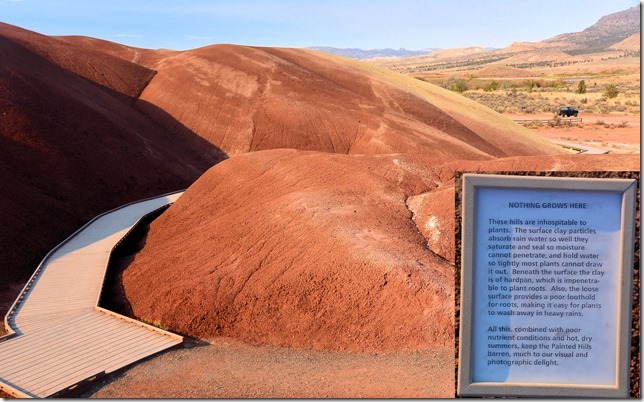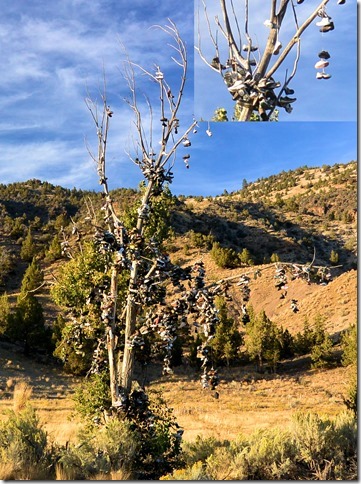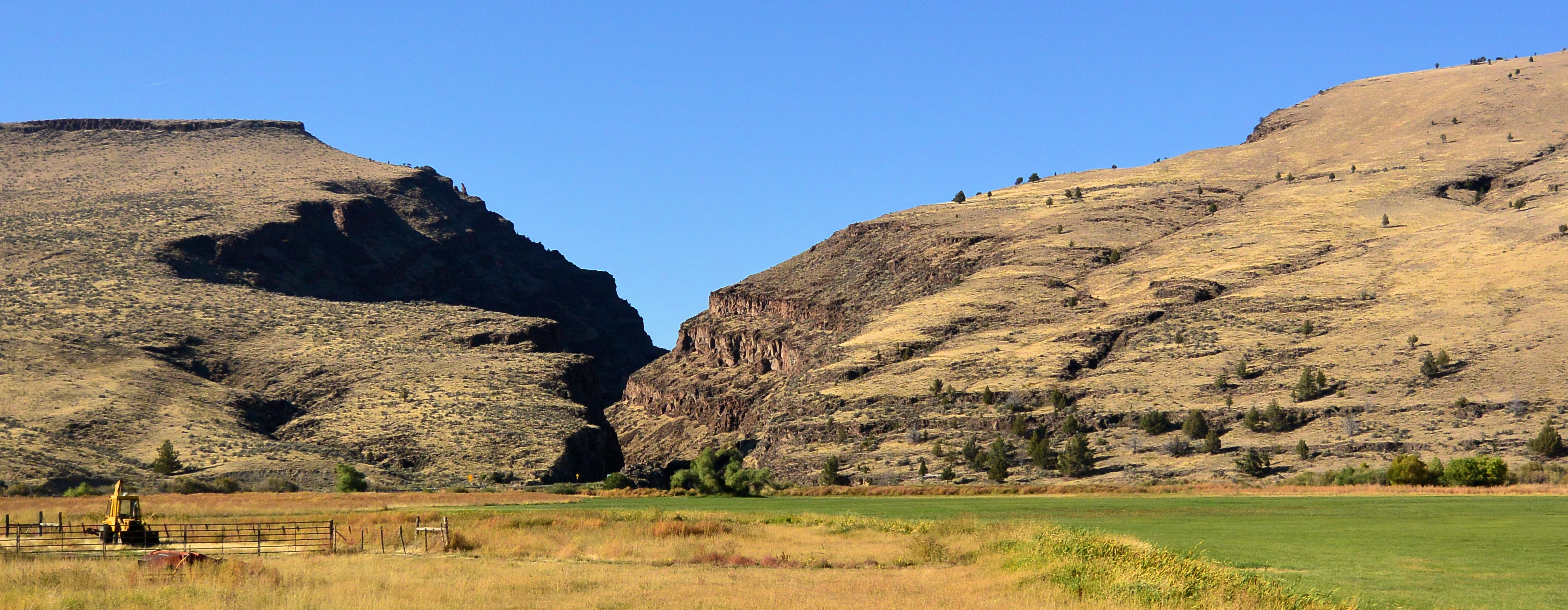John Day Country, Eastern Oregon
The two trappers deftly maneuvered their fur-laden boat around a half-submerged snag, and continued downstream. They checked the riverbanks carefully — for animals, snags, hostile Indians, outlaws. They were in wild, lawless country and anything could happen. Then, along the northern bank came a sight they could never possibly have anticipated. Two naked, half-starved men, crouched at the edge of the water, shouting and waving them over.
It was John Day and a co-traveler, and they had been assaulted by outlaws and robbed of everything they possessed, even their clothes. It was rather odd that they had not simply been killed, and instead left to die of exposure or starvation. In fact, it was such an unusual and noteworthy event that the bend in the river drew forth the sordid tale from every traveler and boatman passing through – “That’s where John Day got robbed naked”, “That’s the bend where they robbed John Day”, “He shot that deer over near the John Day bend”. It was such a tellable story and so widely repeated that the river began to be known as the John Day River, eventually losing its historical Indian name entirely. It is one of those oddities of history, that John Day himself spent very little time in the area after his initial “hazing”.
We had never heard of the place. We were simply “map shopping” Oregon because we had spent nearly zero time in the eastern part of the state. The John Day fossil beds and three National Monument units looked like they needed investigation.
On the outskirts of the fossil region, we almost passed by the Oregon Trail Interpretive Center, stopping on a last-second whim. We’re glad we did, it’s a wonderfully evocative exhibit, bringing to life the times and hardships of the early westward immigrants.
The famous Conestoga wagon: No springs, no tires, just iron and wood to carry goods and supplies 2,000 miles across the wilderness. Beautifully restored.

Trail-side deaths were common; one in ten died on the overland journey. Burials averaged one for every 80 yards of trail. The exhibit’s dioramas are excellent, like this one of a mother weeping over her child’s hasty grave. (Traveling by land was for poor folks. The wealthier immigrants chose sailing, all the way down and around South America’s Cape Horn and up to San Francisco, as the faster and safer route.)

You know the measurements of bison, 7-foot at the shoulder, 2000-pounds plus. You see them in Yellowstone and other places. But try standing next to one (mounted, not live) for a real sense of the majesty of this beast.

Further west, we approached the Monument. The road into the first unit (Sheep Rock) gave us a hint of some of the geology we could expect.

These days, John Day country is quite a bit more civilized than when poor John was stripped clean. But it is still very open, sparsely populated, and looking a lot like when the early explorers and trappers walked through it. There are a few tiny towns, lots of ranches and farms, and a big handful of lovely squiggly roads that weave through the many formations in the region.

For those who know of John Day country, one simple word evokes the essence of the area: FOSSILS. And not just any old ho-hum dinosaur boneyard, not at all. The John Day fossil beds are younger layers, dating back to ‘only’ about 44 million years ago (mya). Remember, the dinosaurs died off around 65mya – so these more-recent fossil beds contain really special remains, those of mammals. Furthermore, the way the fossil remains were created is unique in North America, as are the dense concentrations here.
This region, just east of the present-day Cascade mountain range, was heavily volcanic between 45mya and 15mya. The volcanism of the area was incredibly regular, burying thousands of square miles of land under a variety of lava flows, pyroclastic flows, and ash deposits. This happened over and over and over again. One of the canyons on the scenic drive (“Journey Through Time”) has 17 separate lava-flow layers. Each time the land was inundated, the animals would run away (mostly), the plants would get buried and eventually fossilized, and then things would cool down. Wind and water would bring back the plants, animals would follow, and a few hundred or thousand millennia later, another eruption, repeat. And repeat, and repeat. Oh, and don’t forget to add in some plate-tectonic crushing, tilting, and folding of the strata during this whole process.
Today, paleontologists are fascinated by the density and profusion of fossil remains; but in addition, they use a precise dating technique in each lava or ash layer to give them an outstanding time-scale reference for the layers and their contents. The time-dating is of such accuracy that scaling down to 0.1mya is possible – a very small slice of geologic time. The result is a rich body of knowledge and a collection of over 2,000 specimens unique to the region, much of which is available for travelers like us to peruse as exhibits or signage and placards.
But to be honest, for us non-paleontologist types, the fossils tend to be somewhat arcane. Truth be told, it’s the geology that captures our eye and our awe. The landscape views alone are worth a visit – there are about 15,000 vertical feet of strata on display across the area. Some of it is reminiscent of Bryce Canyon’s spires, some looks like the Grand Canyon, some reminds of Arizona’s Painted Desert; other areas are unique.



There’s no camping in the (smallish) Park Units, but there are multiple choices outside, from regular RV Parks to BLM camps (our favorites). We chose the Lone Pine BLM camp up near Kimberly, with a spacious water’s edge perch on Mr. Day’s river.

We spent a day driving around the area, through the three different Monument Units, and taking some hikes along the trails. Some smoke from a prescribed burn dulled the early morning, but the mid-day and afternoon skies were clear and beautiful. One hike took us along a cliff face with a fissure in it that has weathered into an arch of sorts.

The water that forms the fissure wears unevenly at the different layers. The result is a set of vertical whoop-de-doos down through the formation.

Across from the Arch, this low mound of hills is all that is left of the 40-million-year-old volcano that belched out ash and lava to create the formations.

It’s easy to see how the Painted Hills Unit got its name – – –



Most fossils are removed as soon as they are discovered, because the weather destroys them quickly. Here’s one that was saved for us hikers – – –

– – – an another, two large petrified logs embedded in the cliff face (forming a T).

The formations are scattered around throughout the different units, and it made for a great day of driving and hiking.





As we drove back to camp that afternoon, we were treated to a bit of a giggle. Way out here, close to the middle of nowhere, somehow a shoe tree got started.
The next day called for camping in a volcano caldera.
Stay tuned.

Thanks so much Greg and Karen for the wonderful pictures and blogs. Your amazing journey has been a wonderful learning experience for me and I have thoroughly enjoyed all of it. Bless you for sharing your adventures with the rest of us. See you soon. Love, Irene
Your J. Day photos are pretty good, I’m surprised at the clarity and color. I’ve spent a fair amount of time over there.
I don’t have a working website, but you can try my older littledots site. FYI I’m the engineer you met on Kleinschmidt Grade.
Nick, thanks, it’s good to hear from you.
Most of my published photos are “tuned up” a bit using Corel Paintshop Pro. Cheaper than Adobe and does the job for me. Sometimes even my Nikon V2 comes out with some pretty cruddy stuff, and I’m able to get most of it presentable. All that said, it was a photographer’s day in the afternoon at John Day. Didn’t need much processing.
The John Day area is so gorgeous to fly over also. I had that opportunity one time when the Idaho fires created a lot of smoke and our camp out to Johnson Creek got smoked out. We elected to fly towards the Columbia River and fly/ski towards Portland. We spent a lot of time over the Lake there in John Day country, scoped out the airport (which had no one or nothing there but a great strip) before we headed for the river. Glad you had the opportunity to view it in much closer focus. Have fun!
Weav